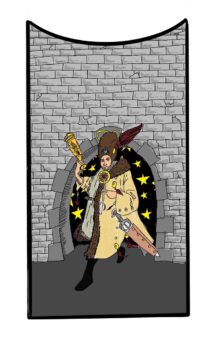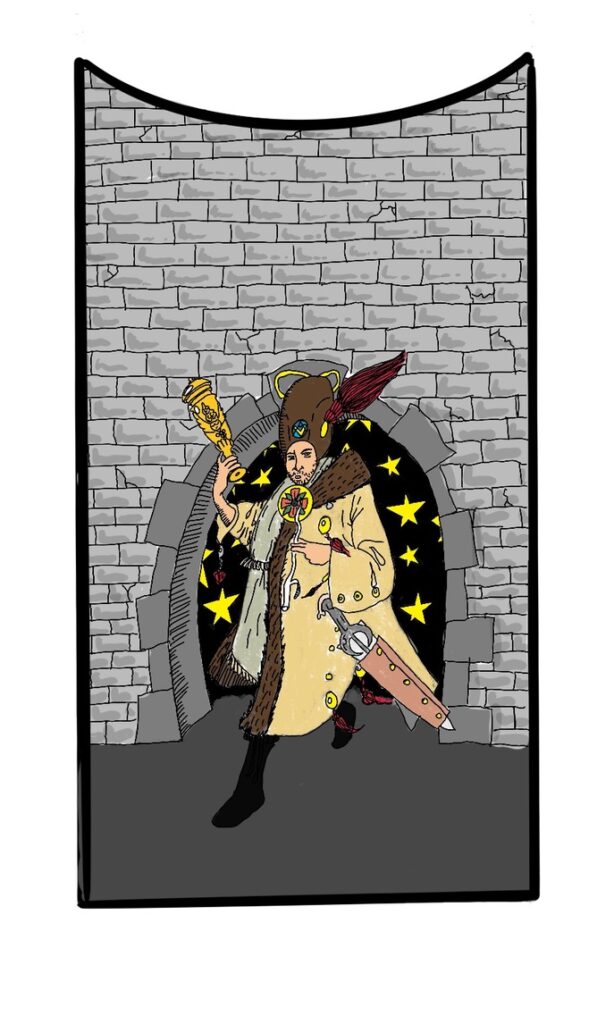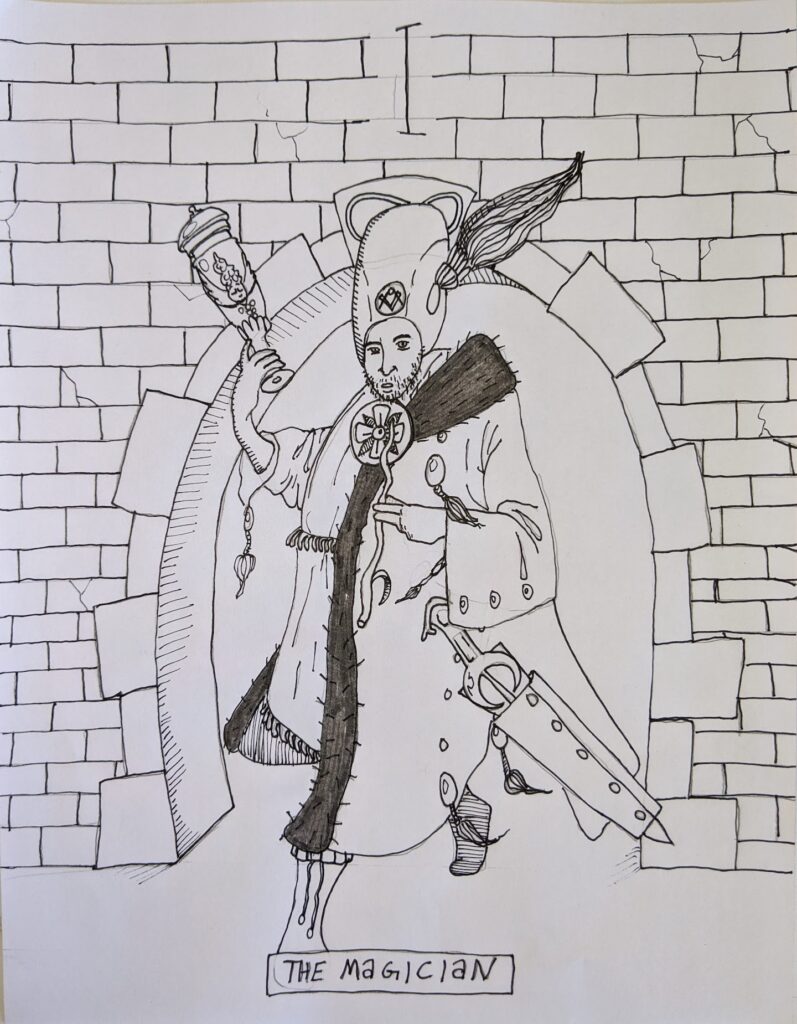In my last blog, I explain why I am doing a tarot deck and that I have also written a book about the cards. I also go over the more technical details of the Fool card and some of its meaning. The Fool is the central character of the Infinite Tarot deck as he goes card to card interacting with each character. They all have lessons for the Fool to learn.
The very first card in the Fool’s journey, and is also the number one card of the deck, is the Magician.
The card shows a sharply dressed young man in front of a tall wall and an entrance. The man is holding a giant ornate grail, and in his other hand, he waves a wand. In a sheath on his side is a saber, and the pentacle is a crest on his chest. These are all the tools he uses to solve life’s complexities.
While a magician can bring to mind an elder, a wise man, the Magician is young and relies entirely on his tools to teach his disciples and practice his magic. He is eager to be the wise man he wishes to be but lacks experience or wisdom. He isn’t without lessons to teach, but like many younger yogis, he still finds his voice.
The wall is the last barrier between our world and the infinite universe beyond. It still makes sense here. The Magician wishes to be the only teacher the Fool needs and won’t need to travel beyond the barrier. Some lessons fall on the Fool’s ears, and others are beyond him. The Fool isn’t ready for some lessons, and the Magician isn’t yet prepared to teach other lessons.
Think how Obiwan Kenobi failed young Anakin Skywalker as a teacher. Knowing when to push and when to give a person space to learn their lessons is the skill that young teachers lack. They wish to be the message and not just a messenger or even allow someone or something else to be the messenger. Some can only learn by experiencing the pain and suffering, no matter how clear the teacher is.
The arch in which the Fool will go when he is finished with the Magician is full of stars; it is the infinite universe beyond the mundane reality that we live in. We can become comfortable with the status quo and traditions and not seek the stars. We keep our feet planted on earth and our heads buried in the world, not the sky, realizing our dreams. The Magician’s get-up is similar to the bureaucratic Hiropthant’s outfit, the uniform of institutions, and the archway is a gateway beyond our human restrictions.
At some point, the Fool, like us, decides to leave the usual means of knowledge and education and strike out on our own, and we must be ready to face fears and walk into the unknown—people who make decisions to never go down the unknown road never truly live.
The Magician has the four minor arcana symbols represented. The Cup symbolizes emotions and love; the sword symbolizes reason and action; the wand represents creativity and will; and the pentacle represents the material body or possessions. Like all things, the cup can’t just mean emotions and love, these things are too complex for that, but the Magician doesn’t understand complexity yet. He is great to introduce these ideas at first, but the Fool will need much more to bring to heart these ideas truly.
The Magician has a giant feather in his hat, which, like the laurel wreath, means there has been an accomplishment that deserves to be known, but one achievement is not enough to be the old teacher on the mountain that the Magician so wishes to be.
Traditional Magician cards have the tools of the trade on a table in front of the Magician who is showing them off. The Magician has the infinity sign above his head or incorporated into his hat.
The Magician represents pure will by using his tools instead of finding a source deep inside of himself. He is the Alchemist who thought it was turning lead into gold and missed that it is an allegory for turning our fears and ego into humility and love. While it can be a negative idea, using the will, for many of us, we have to act our way into better thinking.
In the traditional cards, the Magician usually points a baton into the sky and then points toward the ground. This is the “as above, so below” saying, which is that the earth is a reflection of heaven or that the macrocosm, the universe, reflects the microcosm, us. There is an interconnection with all. We are all one.
When the lion bites the gazelle, it is biting its own flesh.
While we are finite, we are part of the infinite. The Magician is the first border between our microcosm reality, delving into the macrocosms and seeing how the stars and black holes can teach us about ourselves.
This also means that we are so small that our problems are so minor that it is pure magic that we are even experiencing these things. We can forget that we are alive for such a short time and that our purpose isn’t to be stuck in the mire of our own fears. We must go out and be in wonder and love!
The Magician is partly human in the sense that he may have also found himself in this world but could not go beyond the archway to discover his soul; he stays behind and greets the Fools as they plummet from the precipice above, through the mist, and lie at his boots. He has found coping tools for this side of the barrier, but the coping skills are sophomoric and sometimes don’t work.
We actually must scream into the void. The darkness of the corridor is similar to the deep cave the Devil lies in, waiting to bring the terror of anxiety to any who dares to enter. The cave is darker than anything, where the cave leads to is unknown, and the Devil is at the Fool’s back, breathing curses into his ear.
Courage isn’t a shield that protects us from what scares us, but the ability to walk through it knowing we will get to the other side and be okay.
The Magician can only teach the Fool how to cope with what the Magician can cope with, but the Fool, who is us, must go into the abyss and be ready to accept the void or maybe the next card.





